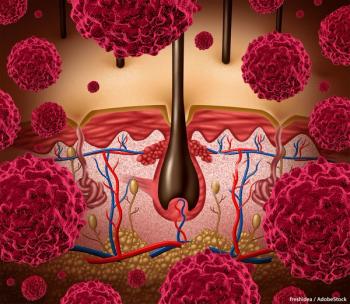
Oncology NEWS International
- Oncology NEWS International Vol 5 No 6
- Volume 5
- Issue 6
Study Shows Melanoma Patients Benefit From High-Dose IFN Despite Toxicity
ASCO--A randomized ECOG study of patients with high-risk melanoma showed significant gains in overall and recurrence free survival for adjuvant high-dose interferon alfa-2b (Intron), but also showed that the high-dose regimen has significant side effects. However, a new quality of life analysis suggests that, for most patients, the benefits of interferon clearly offset its toxicity, Bernard Cole, PhD, of Brown University, said at an ASCO scientific session.
ASCO--A randomized ECOG study of patients with high-risk melanomashowed significant gains in overall and recurrence free survivalfor adjuvant high-dose interferon alfa-2b (Intron), but also showedthat the high-dose regimen has significant side effects. However,a new quality of life analysis suggests that, for most patients,the benefits of interferon clearly offset its toxicity, BernardCole, PhD, of Brown University, said at an ASCO scientific session.
The study evaluated the tradeoff between toxicity and improvedclinical benefit by applying the Q-TWiST technique (Quality-AdjustedTime Without Symptoms or Toxicity) to the ECOG data.
The method examines the time spent in health states that may representdiminished quality of life, ie, time with treatment toxicity andtime with disease relapse, as well as time with no symptoms orrelapse (best possible health). These health states are then weightedto reflect possible patient preferences.
Results indicate that patients who received interferon comparedto observation spent 3 additional months in a state of best possiblehealth, and 2 fewer months in relapse. These gains came at a costof spending 6 months on average with treatment toxicity.
The study found that regardless of the relative value placed onthe health states, the interferon group had more quality-adjustedtime than the observation group.
The gain was significant for patients who place a high relativevalue on toxicity (greater than 0.9) and a low relative valueon relapse (less than 0.4). Such a patient would consider theside effects of interferon to be manageable and would be devastatedby disease relapse, he said.
When the analysis was restricted to node-positive patients, whomade up 90% of the study sample, the interferon benefit was significantfor any case in which a patient places a higher value on timewith toxicity than time with relapse.
Based on these results, Dr. Cole and his colleagues suggest thatphysicians carefully discuss with patients the risks and benefitsof high-dose interferon to assess the patient's tolerance fortoxicity and relapse. When the optimal treatment is not clear,patients may wish to test their tolerance to interferon for aperiod of time, he said.
The discussant, Dr. Vernon Sondak, said that it is important forclinicians to understand "the significance of a significantQTWiST." Many patients still refuse to take interferon becauseof side effects, he said, "so if it is true that everyoneought to take it, then perhaps we all need to learn to betterintegrate the QTWiST analysis data with the clinical data."
Dr. Sondak was troubled by Dr. Cole's suggestion that cliniciansoffer patients a trial of interferon, calling the approach "dangerous,given how difficult it is to get a patient through a year of toxicity.Such decisions need to be made up front."
Dr. Cole responded that "the real danger is that toxicity-tolerantpatients may not begin the therapy out of fear. We are simplyproposing that patients who are unsure be given the opportunityto learn more about their preferences."
Articles in this issue
over 29 years ago
Psychosocial Oncology May Benefit From System Reformover 29 years ago
Managed Care Reform: Wait Until Next Year for House, Senateover 29 years ago
Converting Quality of Life Data to 'Q' Scores Allows Comparisonsover 29 years ago
Shorter Paclitaxel Infusions Add to Neuropathy Riskover 29 years ago
Breast Cancer Mortality Rates Downover 29 years ago
Pain Scale Resembling Thermometer May Be Easier to Use Than VASover 29 years ago
Immediate Hormone Therapy Improves Prostate Cancer Survivalover 29 years ago
New Test for Prostate Cancer Riskover 29 years ago
Topotecan: Significant Activity in Ovarian CancerNewsletter
Stay up to date on recent advances in the multidisciplinary approach to cancer.


















































































